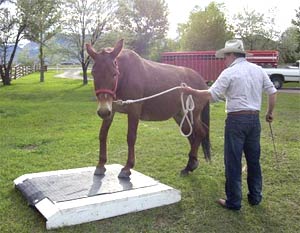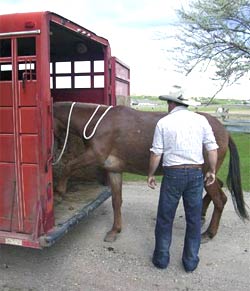Trailer loading is a unique challenge for many mule owners. When
loading your mule, if properly trained, he will stand at the
entrance to the trailer and wait for his cue to load. Once cued,
he will calmly walk into the trailer, with you outside the
trailer, and wait for you to enter to secure him for the ride.
The most common misconception about trailer loading is that it
is a mystical problem that is not easily solved. However, most
trailer loading issues arise from leading problems. In the
August
issue of Mules and More, I discussed the “Go Forward” cue –
teaching your mule to go forward any time you ask, including
into a trailer.
As I discussed in the the “Go Forward” cue article, once your
mule learns the “Go Forward” cue, many other issues become
easily solved, including trailer loading.
 |
|
BEFORE TEACHING YOUR
mule to load in the trailer, teach him or her to cross
other objects first |
Once your mule understands the “Go Forward” cue, begin using
your cue to teach the mule to walk over and across different
obstacles. Crossing several objects before going to the trailer
will give you and your mule the opportunity to refine and
perfect the cue to move forward when asked. Start with a piece
of plywood, a tarp, wooden bridge, sidewalk, etc; something that
your mule is unsure about but not completely terrified of.
Once you are able to walk across an object, build up to objects
that are more difficult. Again, this will allow you and your
mule to continue to work on perfecting the cue.
When your mule is approaching any object you are going to cross,
remember the following guidelines:
1. To ask your mule to begin the process of crossing an object
or entering the trailer, use your cue you have established to
walk forward. This cue will be the only cue you need to teach
your mule. When your mule takes a step or even hints at making
an effort to move forward (like a lean forward), release your
cue and praise him for a job well done. The more you praise him,
the more forward he will get and the more confidence he will
gain.
2. Choose one specific spot on the object that you want your
mule to cross. If you give your mule too much “area” to cross,
it may overwhelm him. Choose a spot the size of a quarter and
keep that spot in mind while you are working towards crossing.
If he moves to the left or the right of the spot you choose,
take him back to the spot and ask again.
3. When you are approaching the object, do not expect your mule
to walk right up to the object and be ready to cross. Start
walking up to your object from several yards away to give your
mule a chance to see what he is going to cross. Wherever your
mule stops in relation to the object is where your mule feels
comfortable, and that is your starting point. That is where you
begin using your cue to ask your mule to move forward, closer to
and eventually over the object or into the trailer.
4. Once you find your starting point, allow your mule to stand
and relax before you begin asking your mule to move forward
closer to the object or trailer.
5. Initially, do not ask your mule to move forward until you are
99 percent certain he will make an effort to do so. When he is
relaxed and seems to be ready to move, ask. When you ask, the
first movement may only be a half step, a full step or even a
“lean” forward. However, BE PATIENT, it may be a minute or 10
minutes before he is entirely ready to move. Be sure to let your
mule set the pace. After your first step or lean, allow your
mule to stand again and relax until he is ready to move again.
6. After several repetitions of asking and getting a step, you
will find your mule getting closer to the object or trailer. As
your mule gets closer and the object is within reach, he may
begin lowering his head and trying to smell the object. He may
even try to paw at the object. LET HIM DO THIS! These behaviors
in this situation are a mule’s way of determining whether or not
it is safe enough to continue. Allow this to happen several
times until you see your mule relaxing and feeling comfortable
with the object.
7. Your mule may try to back away from the object or trailer as
you ask him to move forward. Do not reprimand him, just simply
move with the mule and continue cuing him until he takes at
least one step forward. After he takes a forward step, release
the cue, praise the mule and allow him to rest, then try again.
|
 |
|
TIM HAS CUED Diamond
Creek Angel to load into the trailer and wait for Tim to
secure her inside |
When your mule has one foot on the object or in the trailer,
then follow the same steps to get two, then three, then four
feet in the trailer. Be sure to repeat this process hundreds of
times over several weeks. Repeating will solidify the lesson and
ensure your mule understands what you want.
As you begin to get closer to the object or trailer, continue to
stay patient and be sure to praise your mule each time he takes
a step or makes an effort to move forward.
Once your mule is standing right in front of the object or
trailer, you are then looking to get just one foot on the object
or in the trailer. The first attempt will likely be your mule
lifting his foot up then putting it back down on the ground.
After several “lift and lower” attempts, next he will likely
place his foot on the object or in the trailer, then place it
back on the ground. This is progression in the right direction.
Again, be patient and allow your mule to figure out that it is
safe.
As your mule places a front foot, then the other front, hind,
etc, be sure to ask your mule to back out with each foot also.
Just like walking in, you have to give your mule a chance to
walk out of the trailer as well.
Unloading
Many mules will not back out of a trailer. Many times mules must
turn around inside the trailer in order to unload. I want my
mules to slowly back out of the trailer on my cue.
In order for the mule to back out of the trailer, he must be
taught to back up. Again, be sure to back the mule off the
trailer after he places each foot in the trailer. As your mule
places a front foot, then the other front, hind, etc, be sure to
ask your mule to back out with each foot also. Just like walking
in, you have to give your mule a chance to walk out of the
trailer as well.
Also, remember you do not need to load the mule in the trailer
today. You can stop the lesson anytime the mule responds to your
cue by moving forward. As long as your mule is calmer then when
you started and has progressed, even a little, you can end your
lesson.
Do not over-concentrate on your goal. Be sure to see the
progression your mule is making towards your goal. If you rush
or force your mule, it will take you twice as long and you will
create additional hurdles to your goal.
When training your mule for anything, the slower you go, the
faster you will reach your goal, whether it be teaching a
sliding stop or loading in a trailer. Allow the progression to
happen at the pace your mule sets. Before you know it, your mule
will be eager and happy to load in the trailer.
Now, getting to that trail ride, show or clinic you have always
wanted to attend is simple, let’s load up and go. See you there!
What’s with the noise?
After your mule is consistently walking in and out of the
trailer several times, do so one more time. This time, ask your
mule to stay in the trailer. Once your mule is standing inside
the trailer start rattling the back door a little, open and
close a window, begin making small noises around your trailer to
make sure your mule is comfortable being inside. If the mule
comes out of the trailer at any time, load him back inside the
trailer and start with even smaller noises. Again, be patient.
The object is to get your mule use to your trailer and the
noises it makes, but not to scare him enough that he feels he
must leave. Slowly work up to louder and scarier noises. When
the mule accepts all trailer noises, you can walk into the
trailer and secure the mule for the trailer ride.
Tim can be reached at
www.diamondcreekmules.com, or by phone at 307/899-1089, or
email:
bliss@wavecom.net.
|